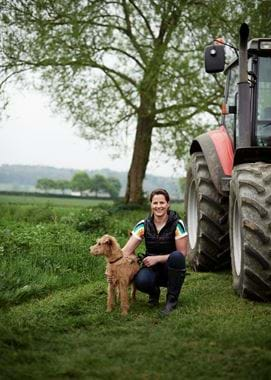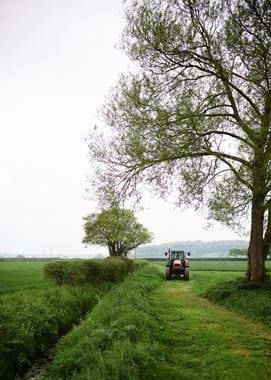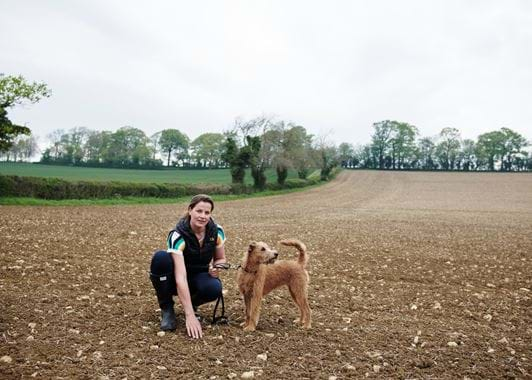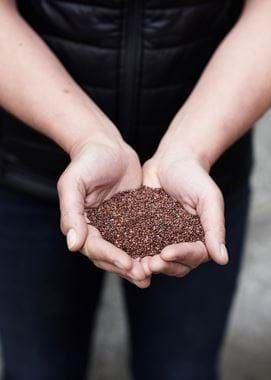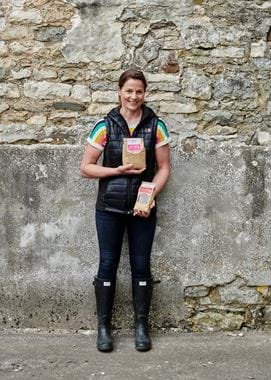Sourcing stories: Bath Farm Girls
Sourcing stories: Bath Farm Girls
The first of only a few growers of British quinoa, Emily’s local farm is home to field upon field of red and white nutty, crunchy quinoa. It’s Emily’s brand, Bath Farm Girls, that fills dishes like our goodness bowls at our Bath-based café, The Provenist. In this exclusive Q&A, she shares her story, from what brought her to this notoriously hard-to-grow grain to who really are the ‘farm girls’…
Why and when was it that you set up Bath Farm Girls?
“The farm [Corston Fields Farm] has always been my home since I was a little girl. We grow linseed, barley and wheat on the whole for animal feed, but I wanted to diversify and try something new, something unique. I wasn’t sure what it was going to be; I was open to all sorts of ideas, and I still am. But quinoa sort of fell into my lap. One of my daughters is gluten intolerant, so I’d been cooking with different things to see what she liked and what suited her best. Quinoa was one of those things, and my research made me think, maybe I could have a go at growing that because our ‘Cotswold brash’ soil sounded like it would really suit the crop. It’s alkaline and free-draining, which makes it very dry – something that quinoa loves. In 2013, I did a half-acre trial and now I’m growing more than ever.”
So, business-wise, there’s been a good appetite for buying British-grown quinoa?
“Absolutely. The plant-based diet movement is growing all of the time, and the wellness, nutrition-focussed mindset seems to lead to people caring more about where their food’s from too. All of the upsetting press around Peruvians struggling to afford to buy their native quinoa because of how high the costs are, means that there’s even more interest in finding alternatives – and in reducing food air miles. I’m very happy that we can do something to help there.”
Tell us about the crop. Was it an easy transition and how hard is it to grow?
“Yes, it was an easy transition, yes it’s been easy to grow, but no way is it easy to work with. Quinoa is known for being hard to clean and process. It’s such a high maintenance crop at harvest time. Once it’s actually in the ground, it doesn’t ask for much. There’s not loads that we can do to help it grow. The harvesting side, however, asks a lot of you. Quinoa has a weird static coating which means it sticks to just about everything, so you can only handle it in small quantities. Otherwise, it’s mayhem. There’s loads of shovelling and manhandling which is different to our other crops. You really do have to treat it with a lot of care and attention. I think that’s why it works on a small farm like ours, because we can give it what it needs. We planted it last month, it stays there for about six months, and then we hand-weed the fields from May to July. Harvest time is in early September, but we can use our normal combine harvester for it, just on a different setting, so we haven’t needed to change our ways or invest in new machinery to nurture it.”
You grow two types of quinoa – why’s that?
“Well it all started with just the one variety – white quinoa. But I’ve just planted two thirds white and one third red. The red type came about because the chefs that I supply started asking if we could grow it because it adds a bit of colour and a touch more bite. The nutritional value is about the same though. There’s also black quinoa but I haven’t tried sowing that just yet.”
What’s a typical day like at the farm?
“Generally, I’m up and away by 7am when the kids are packed off to school. At the moment, it’s about tending to the crops. We’ve just finished planting some wildlife areas to help us farm in a way that’s as environmentally-sensitive as possible. I’ve used pollen and nectar mixes as well as adding a wild bird food section to let nature work her magic. June is usually quiet for us as we get the barns ready for harvest, but then it all kicks off in July when the first crops get harvested. We’re flat out until October then. Of course, the weather can throw your day out of the window. Wet days are office and admin days for me. Daylight hours are pretty in tune with farming. It’s late nights and early mornings in spring and summer, but you never quite know what shape the day will take. Arable farming gives you less of a structure compared to when you have livestock because the animals need a routine.”
Do you have any other plans to try new crop at the farm as good company for your quinoa?
“Absolutely, as we have our first English sparkling wine harvest on the go. Our vineyard is two hectares and we harvested for the first time last September, which has been bottled and will be ready in 2021. It’s been so full on. Partly because it’s new to us, but mainly because everything is done by hand, from the pruning to the picking. Hopefully, it’ll be well worth it.”
And who are the ‘Farm Girls’?
“I always worry this is going to sound a bit silly, but it’s me and my two daughters, Rosa and Charlotte. They’re the least helpful out of the three of us. It’s a bit gimmicky really, but I needed a brand name, and my girls were what led me to quinoa. My name on Twitter for years had been Bath Farm Girl, but I didn’t think it sounded or felt right for the business, so I thought, why not throw my girls in too? They’re the taste bud test officials and my biggest critics.”
Try Emily’s quinoa whenever you stop by The Provenist.
Where to find us

